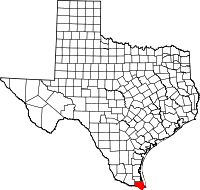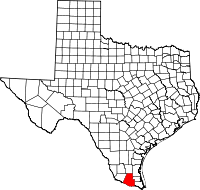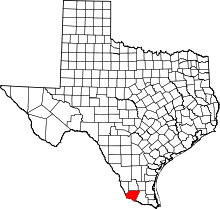Rio Grande Valley
| Rio Grande Valley | |
| Region | |
| Country | |
|---|---|
| State | |
| Population | 1,305,782 (2012) |
| Timezone | Central (UTC-6) |
| Area code | 956 |
 Map of the Rio Grande Valley
| |
| Website: Handbook of Texas: Rio Grande Valley | |
The Rio Grande Valley (RGV) or the Lower Rio Grande Valley (when referring to the eight county region), informally called The Valley, is an area located in the southernmost tip of South Texas. It lies along the northern bank of the Rio Grande, which separates Mexico from the United States.
Geography
The Rio Grande Valley is not a true valley, but a floodplain, containing many oxbow lakes or resacas formed from pinched-off meanders in earlier courses of the Rio Grande. Early 20th-century land developers, attempting to capitalize on unclaimed land, utilized the name "Magic Valley" to attract settlers and appeal to investors. The Rio Grande Valley is also called El Valle, the Spanish translation of "the valley", by those who live there.[1] The residents of the Rio Grande Valley occasionally refer to the area as "El Mágico Valle del Río Grande" ("The Magical Valley of the Rio Grande"), and also simply by the initials R.G.V.
The main region is within four Texan counties: Starr County, Hidalgo County, Willacy County, and Cameron County. As of January 1, 2012, the U.S. Census Bureau estimated the population of the Rio Grande Valley at 1,305,782.[2] According to the U.S. Census Bureau in 2008, 86 percent of Cameron County, 90 percent of Hidalgo County, 97 percent of Starr County, and 86 percent of Willacy County are Hispanic.[3]
The largest city is Brownsville (Cameron County), followed by McAllen (Hidalgo County). Other major cities include Harlingen, Edinburg, Mission, Rio Grande City, Raymondville, and Pharr.[4]
Tourism
The Lower Rio Grande Valley encompasses landmarks that attract tourists, and popular destinations include: Laguna Atascosa National Wildlife Refuge, Santa Ana National Wildlife Refuge, and Bentsen-Rio Grande Valley State Park; and on the coast Padre Island, Brazos Island, and the Port Isabel Lighthouse
The Valley is a popular waypoint for tourists visiting Northeast Mexico. Popular destinations across the border and Rio Grande include: Matamoros, Nuevo Progreso, Río Bravo, and Reynosa, all located in the Mexican state of Tamaulipas.
The Valley also attracts tourists from the Mexican states of Tamaulipas, Nuevo Leon, Coahuila, and Mexico, D.F. (México City).
Places of historical interest

- First Lift Station
- Los Ebanos Ferry, last hand-operated ferry on the Rio Grande
- La Lomita Historic District
- Fort Brown
- Palo Alto Battlefield National Historic Site
- Resaca de la Palma
- Rancho de Carricitos[5]
- USMC War Memorial original plaster working model, located on the campus of the Marine Military Academy in Harlingen
- Museum of South Texas History, originally the County Court House and Jail, built in the late 19th century
- Battle of Palmito Ranch, location of the last battle of the Civil War
- Brownsville Raid
- Battle of Resaca de la Palma
Economy
The Valley is historically reliant on agribusiness and tourism. Cotton, grapefruit, sorghum, maize, and sugarcane are its leading crops, and the region is the center of citrus production and the most important area of vegetable production in the State of Texas. Over the last several decades, the emergence of maquiladoras (factories or fabrication plants) has caused a surge of industrial development along the border, while international bridges have allowed Mexican nationals to shop, sell, and do business in the border cities along the Rio Grande. The geographic inclusion of South Padre Island also drives tourism, particularly during the Spring Break season, during which South Padre Island becomes reminiscent of New Orleans during Mardi Gras. During the winter months, many retirees arrive to enjoy the warm weather, access to pharmaceuticals and health care in Mexican border crossings such as Nuevo Progresso. There is a substantial health-care industry with major hospitals and many clinics and private practices in Brownsville, Harlingen, and McAllen.

Texas is the third largest producer of citrus fruit in United States, the majority of which is grown in the Rio Grande Valley. Grapefruit make up over 70% of the Valley citrus crop, which also includes orange, watermelon, tangerine, tangelo and Meyer lemon production each Winter.[6]
There are six semi-professional sports teams that play in the Rio Grande Valley: the Rio Grande Valley Whitewings (baseball), the Edinburg Roadrunners (baseball), the Rio Grande Valley Flash (indoor soccer), the Rio Grande Valley Vipers (basketball), the Rio Grande Valley Bravos (soccer), and the RGV Sol (indoor football).
Education
Colleges and universities located in the Rio Grande Valley include:
- University of Texas at Brownsville
- University of Texas–Pan American
- Texas Southmost College
- Texas State Technical College
- South Texas College
- University of Texas Health Science Center - Regional Academic Health Center[7]
In 2015, UT-Brownsville and UT-Pan American will merge to become The University of Texas–Rio Grande Valley. The new university will include a medical school.
Hospitals
- Cornerstone Regional Hospital, Edinburg, Texas
- Edinburg Children's Hospital, Edinburg, Texas
- Edinburg Regional Medical Center, Edinburg, Texas
- Doctors Hospital at Renaissance, Edinburg, Texas
- Harlingen Medical Center, Harlingen, Texas
- McAllen Heart Hospital, McAllen, Texas
- McAllen Medical Center, McAllen, Texas
- Rio Grande Regional Hospital, McAllen, Texas
- Rio Grande State Hospital, Harlingen, Texas
- Solara Hospital, Harlingen, Texas
- VA Health Care Center at Harlingen. Harlingen, Texas
- Valley Baptist Medical Center, Harlingen, Texas
- Valley Baptist Medical Center, Brownsville, Texas
- Valley Regional Medical Center, Brownsville, Texas
- Knapp Medical Center, Weslaco, Texas
- Mission Regional Medical Center, Mission, Texas
Media
Magazines
- The Go Guide - published by Above Ground Media, LLC rgvgoguide.com
- Celebrity Group Magazines - owned by Celebrity Group Advertising Agency
- Rio Grande Magazine
- ((www.viva-el-valle.com)) owned by viva el valle magazine
Newspapers
- El Extra - owned by AIM Media Texas
- El Nuevo Heraldo - owned by AIM Media Texas
- The Brownsville Herald - owned by AIM Media Texas
- The Island Breeze - owned by AIM Media Texas
- The Mid Valley Town Crier - Owned by AIM Media Texas
- The Monitor - owned by AIM Media Texas
- Valley Morning Star - owned by AIM Media Texas
- Valleywood Magazine - owned by Valleywood Publications
- ((www.viva-el-valle.com)) - owned by Viva el Valle internet magazine
Local Blogs
- Viva South Texas - owned by White Coyote Productions[8]
- Ouch, My Ego! - Local alt news blog[9]
Television
- KGBT-TV/DT Action 4 News, CBS Affiliate
- KRGV-TV/DT Newschannel 5, ABC Affiliate
- KVEO-TV/DT News Center 23, NBC Affiliate
- KCWT-CD 21, The CW Affiliate
- KTFV-CD 32, Telefutura Affiliate
- KMBH TV/DT 38, PBS Affiliate
- KLUJ-TV/DT 44, TBN Affiliate
- KTLM-TV/DT 40, Telemundo Affiliate
- KNVO TV/DT 48, Univision Affiliate
- KFXV-LD 67, Fox 2 News, Fox Affiliate
Radio
|
|
Notable people
A list of notable people who were born, lived, or died in the Rio Grande Valley includes:
- Ana Brenda Contreras (Mexican Actress and Singer)
- David V. Aguilar (Chief Border Patrol Agent, United States Border Patrol; Rio Grande Valley Station, Texas)
- Micaela Alvarez (Federal judge; Donna, Texas)
- Natalia Anciso (Contemporary Artist; Weslaco and Mercedes, Texas)
- Gloria E. Anzaldúa (Writer/Poet; Hargill, Texas)
- Cathy Baker (T.V. performer; Edinburg, Texas)
- Lloyd M. Bentsen, Jr. (U.S. Secretary of the Treasury, U.S. Senator, U.S. Representative; Mission, Texas)
- James Carlos Blake (Novelist, Brownsville)
- Harlon Block (Iwo Jima flag raiser, died on Iwo Jima; Weslaco, Texas)
- William S. Burroughs American writer, his time as a farmer in the valley in Pharr, Texas is briefly chronicled in his books Junky and Queer
- Rolando Cantu is a Mexican football player who used to play for the Arizona Cardinals in the U.S. and graduated from McAllen High School; McAllen, Texas.
- Thomas Haden Church (Actor; Harlingen, Texas)
- Kika de la Garza (U.S. Representative; Mission, Texas)
- Freddy Fender (Musician/Actor lyricist; San Benito, Texas)
- Mike Fossum (Astronaut; McAllen, Texas)
- Reynaldo Guerra Garza (Judge for the United States Court of Appeals for the Fifth Circuit; Brownsville, Texas)
- Roberto Garza (Professional Football Player Chicago Bears; Rio Hondo, Texas)
- Tony Garza (U.S. Ambassador to Mexico; Brownsville, Texas)
- Alfredo C. Gonzalez (Medal of Honor Recipient, U.S. Marine Veteran; Edinburg, Texas)
- Matt Gonzalez (2008 Vice Presidential candidate; former president of the Board of Supervisors of San Francisco, California; born, McAllen, Texas)
- Esteban Jordan (Accordionist; Elsa, Texas)
- Bill Haley (Musician; Harlingen, Texas)
- Catherine Hardwicke (Film director, writer, producer; McAllen, Texas)
- Rubén Hinojosa (U.S. Representative, Edcouch Elsa, Texas)
- Kris Kristofferson (Musician, actor, song writer; Brownsville, Texas)
- Tom Landry (American football coach, Mission, Texas)
- Bobby Lackey (College Football Player; Weslaco, Texas)
- Jose M. Lopez (Medal of Honor Recipient; Mission, Texas)
- Roy Mitchell-Cárdenas (Musician in rock band MuteMath; McAllen, Texas)
- Jack Morava (Mathematician at Johns Hopkins University; Mercedes, Texas)
- Rachel McLish (Ms. Olympia, actor; Harlingen, Texas)
- Bobby Morrow (Olympic gold medalist; San Benito, Texas)
- Major Samuel Ringgold (Father of modern artillery, served at what is now Fort Ringgold; Rio Grande City, Texas)
- Charles M. Robinson III (Author; San Benito, Texas)
- Valente Rodriguez (Actor; Edcouch, Texas)
- Ricardo Sanchez (U.S. Army lieutenant general; Ground forces commander in Iraq; Rio Grande City, Texas)
- Julian Schnabel (Filmmaker; Brownsville, Texas)
- Merced Solis aka Tito Santana (Wrestler; Mission, Texas)
- Nick Stahl (Actor; Harlingen, Texas)
- Rigo Tovar (Musician/actor/composer; Matamoros, Tamaulipas)
- Filemon Bartolome Vela (Federal judge; Harlingen, Texas)
- Eric Miles Williamson (Novelist/Literary Critic/Professor; McAllen, Texas)
See also
- Flora of the U.S. Rio Grande Valleys
References
- ↑ Winter Texan Resources for South Padre Island, Brownsville, Harlingen, and the Rio Grande Valley
- ↑ 2012 Census Estimates
- ↑ Texas Lower Rio Grande Valley Fact Sheet
- ↑ Population Estimates for Rio Grande Valley Cities 2000-2004
- ↑ National Park Service: Rancho de Carricitos
- ↑ Rootstock and Scion Varieties by Julian W. Sauls, Professor & Extension Horticulturist, Texas AgriLife Extension
- ↑ RAHC Vision Statement
- ↑ http://www.vivasouthtexas.com/about-us.html
- ↑ http://ouchmyego.com/about-ouch-my-ego/
External links
| Wikivoyage has a travel guide for Rio Grande Valley. |
- Texas State Historical Association — Lower Rio Grande Valley
- Rio Grande Valley Partnership: Valley Chamber
- Rio Grande Valley Sports Information Center
- South Padre Island Turtle Cam
- Rgvattractions.com: Attractions in the Rio Grande Valley
- Rio Grande Valley Community Foundation
- RGVPride.com
- Los Ebanos, TX
- Wintertexaninfo.com: The Winter Texan Connection
| |||||||||||||||||
| |||||||||||||||||||||
| |||||||||||||||||||||
| ||||||||||||||||||||||||||



